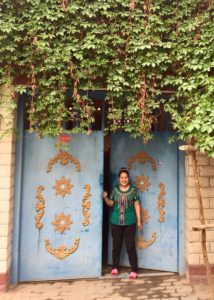 This part of China is known for the growing of grapes and other fruit which you’ll see being sold by the locals on the streets as far away as Shanghai. When the grapes are picked, they are dried in special buildings made of mud bricks. The houses are the same construction too and generally feature an open courtyard behind large highly decorated colourful front doors.
This part of China is known for the growing of grapes and other fruit which you’ll see being sold by the locals on the streets as far away as Shanghai. When the grapes are picked, they are dried in special buildings made of mud bricks. The houses are the same construction too and generally feature an open courtyard behind large highly decorated colourful front doors.
The temperature in the summer is great for groing grapes but a challenge to live in so the houses have open brickwork near the eaves which keeps the courtyard cool and a large day bed to fit an entire family. I got invited into one such house and the temperature inside was noticeable cooler.
Everything in XinJiang seems to have risen out of the ground, all the same colour as the earth. The traditional buildings in the villages are more often than not made from mud bricks and stuck together with mud and straw. It’s an ancient style of building which has, over time, proved the most effective and financially viable way of keeping cool.

In Kashgar I was lucky enough to be invited into the inner sanctum of a house of a woman in the old town. She gave me flat bread and hot water and offered to cook me lunch. I declined the lunch knowing that it would probably be fatty lamb and I knew I would not be able to get it anywhere near my mouth without feeling sick.
So I took the bread and water and sat for 10 minutes in her private room. It was the first time I had made it through the courtyard area of any of any of the houses and people I had met here. 
In the centre of the room was a large low wooden table covered with a cloth and then (for the dust) a semi-transparent decorative plastic sheet on top of which was piled three large flatbreads.
The floor was tiled but completely covered with decorative (mostly red) woollen mats on which she laid a folded decorative seating mat for me, at the table. Along the walls were floor to ceiling frilly curtains and dark wooden cupboards. There was nothing else in the room except for the table and seating mats rolled up and placed along one wall.
The houses in rural XinJiang look lovely… from a tourist’s point of view. I doubt whether very many who marvel at their beauty would actually want to spend a night there, let alone a lifetime. I have realised on this trip that my days of hostelling are over.
The hostel I stayed in in the old town of Kashgar was probably the last I will ever use. I stayed one night and then booked into the Radisson Blu! So I definitely could live in a traditional house.